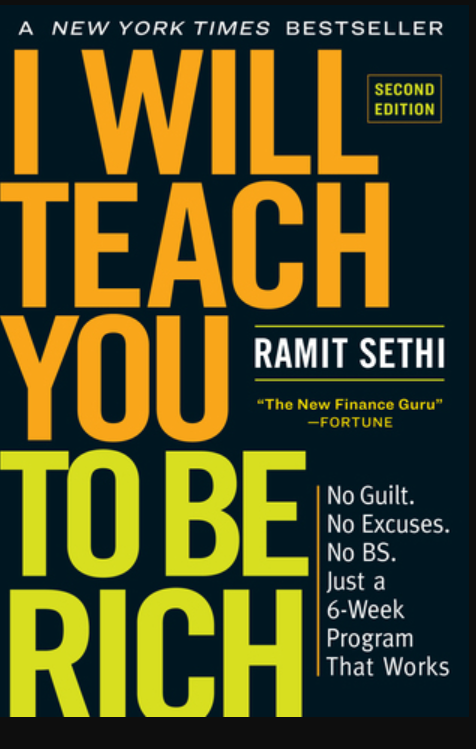Ramit Sethi, in a very simple, funny and relatable tone, wrote one of the best personal finance books of this generation, I Will Teach You To Be Rich. Revised and updated after the financial crash of 2008, Sethi’s enormous bestseller started as personal blog in 2004 and grew to a multi-million empire offering consultation, advice, books and courses.
In this blog post, we have summarized the best ideas, the main concepts of the book I Will Teach You To Be Rich.
I Will Teach You to Be Rich Summary
Commonly known as IWTYTBR for its long title, Sethi collected his most popular and discussed blog posts on his blog of the same name. What began as a project to teach people about personal finance, one topic at a time, turned into a bestselling guide – complete with both offline and online resources to keep your financial freedom journey going long after reading the book.

Sethi goes into many different examples in his book, such as paying down high-interest loans, scripts for negotiating bank fees and focusing on achieving goals.
Best ideas from the book I Will Teach You To Be Reach
All of the information in this book is extremely useful, and should definitely be read cover to cover, however in an effort to summarize this bestseller, 3 main points stick out that have had, and will keep having, a huge impact on readers:
- Take full responsibility for your financial situation, the good and the bad, and make a plan.
- The eight wonders of the world, compounding, can make even the most disadvantaged person rich
- Investing is simple through automation and convenience
Accept your situation, and make it better
Sethi is no stranger to personal finance books, including Kiyosaki’s Rich Dad, Poor Dad. Both start in an extremely similar fashion, which hits the point home in an honest and blunt way, take responsibility. Most people who are in a poor financial situation, and have climbing debt, prefer to not think about it. Another common thought process with surmounting debt and lack of financial literacy is feeling that the situation can’t be changed and attempting to do so is futile.
Sethi challenges this notion with many examples, and that debt repayment can be fixed in many different ways if it’s clear you can’t dig yourself out. Rates can be negotiated, the amount of the loan can be brought down, and payments can be made automatically. You can also consolidate debt, meaning if you have multiple high-interest debt (such as the enormous 19-24% credit card debt) it can be consolidated against an asset and brought lower, even as low as 3-7%.
The first step is to not make excuses and to stop the flow of misinformation provided by external sources. Social media, well-intentioned family and friends, and the news report what is popular, and not necessarily what’s right. Financial institutions and stores benefit from consumerism, so the more you are spending, the more they are lining their pockets. Pay off high-interest debt, set a budget and make a plan. Once you’ve accepted your situation and made a commitment, you have won half the battle.
Compounding: The Unseen Formula to Wealth
Saving 200 dollars a month for 30 years yields $72,000. Investing 200 dollars a month for 30 years, at a 10% rate compounded monthly yields $457,957. Starting with the same amount 10 years earlier yields over $1.2MM. This is the magic of compounding, exponential gains and returns that eventually outweigh your deposits and accumulates faster and quicker with its own interest and dividends.
Compounding also works against you if you accrue high-interest debt. Imagine in the above example if you spent that money with a 10% loan for years, how quickly the problem could become. You want the power of compounding to work for you and not against you. This is why one of the most important principles is to start investing, even just $1, as early as possible. Setting this habit will allow you to put more and more money aside as you increase your income and not letting your lifestyle get too extravagant with it.
Investing does not have to be difficult. In fact, the simplest strategies, such as investing with the index of the market, is proven to even beat active fund managers in the long term. We used the example of a 10% growth rate for a reason, historically, this is the average of the S&P500, which is the benchmark index capital market.
Automating your investing
In order to take advantage of the wonderful power that is compounding, I Will Teach You to Be Rich’s main message is to automate your budget and investments so that its hands off and out of mind. This is especially important with your pay and your investments. For example, committing to having $100 of your pay automatically invested in an index ETF or fund as soon as it hits your bank account will be a change at first.
After several times, you will not notice that you are missing that $100, and learn to live on the rest. Maybe you make coffee at home more often, or eat out one less time per month. Making small sacrifices and seeing that amount grow over time will drive you to increase your earning power, re-evaluate your budget, and set lofty but attainable goals towards your financial independence. You should also be automating: recurring bill payments, loan payments and setting aside an easily-accessible emergency fund for unseen circumstances.
I Will Teach You To be Rich: The Good, The Bad, and Should I Read It?
It is a difficult thing for reader’s of this book to have a heavy negative outlook. IWTYTBR is not only designed to be a linear progression read cover to cover, but to be used as a tool, reference and even resource. the blog with the same name as the book has hundreds of resources including blog posts, calculators, graphs and sheets to use for your financial planning and budgeting needs.
Overall, I Will Teach You To be Rich makes an amazing gift, and should be read by everyone as early as can be. Financial literacy is unfortunately not a topic that is learned in school. The sooner you know how to effectively manage your spending and start investing, the faster you can live life on your own terms, and have more successful and meaningful relationships.

